Related Research Articles

The Lockheed F-117 Nighthawk is a retired American single-seat, subsonic twin-engine stealth attack aircraft developed by Lockheed's secretive Skunk Works division and operated by the United States Air Force (USAF). It was the first operational aircraft to be designed with stealth technology.

The Lockheed Martin/Boeing F-22 Raptor is an American twin-engine, all-weather, supersonic stealth fighter aircraft developed and produced for the United States Air Force (USAF). As a product of the USAF's Advanced Tactical Fighter (ATF) program, the aircraft was designed as an air superiority fighter, but also incorporates ground attack, electronic warfare, and signals intelligence capabilities. The prime contractor, Lockheed Martin, built most of the F-22 airframe and weapons systems and conducted final assembly, while program partner Boeing provided the wings, aft fuselage, avionics integration, and training systems.

James Harold Doolittle was an American military general and aviation pioneer who received the Medal of Honor for his raid on Japan during World War II, known as the Doolittle Raid in his honor. He made early coast-to-coast flights, record-breaking speed flights, won many flying races, and helped develop flight-test instrument flying.

Elbert Leander "Burt" Rutan is a retired American aerospace engineer and entrepreneur noted for his originality in designing light, strong, unusual-looking, and energy-efficient air and space craft. He designed the record-breaking Voyager, which in 1986 was the first plane to fly around the world without stopping or refueling. He also designed the Virgin Atlantic GlobalFlyer, which in 2006 set the world record for the fastest and longest nonstop non-refueled circumnavigation flight in history. In 2004, Rutan's sub-orbital spaceplane design SpaceShipOne became the first privately funded spacecraft to enter the realm of space, winning the Ansari X-Prize that year for achieving the feat twice within a two-week period.
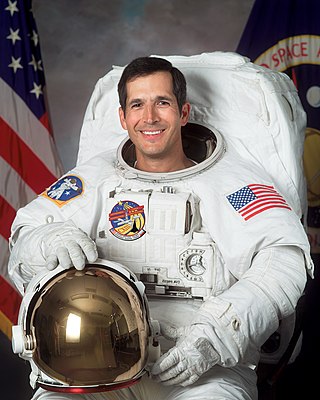
John Bennett Herrington is a retired United States Naval Aviator, engineer and former NASA astronaut. In 2002, Herrington became the first enrolled citizen of a Native American tribe to fly in space.

Robert Franklyn "Bob" Overmyer was an American test pilot, naval aviator, aeronautical engineer, physicist, United States Marine Corps officer, and USAF/NASA astronaut. Overmyer was selected by the Air Force as an astronaut for its Manned Orbiting Laboratory in 1966. Upon cancellation of the program in 1969, he became a NASA astronaut and served support crew duties for the Apollo program, Skylab program, and Apollo-Soyuz Test Project. In 1976, he was assigned to the Space Shuttle program and flew as pilot on STS-5 in 1982 and as commander on STS-51-B in 1985. He was selected as a lead investigator into the Space Shuttle Challenger disaster in 1986, retiring from NASA that same year. A decade later, Overmyer died while testing the Cirrus VK-30 homebuilt aircraft.

Robert Lee Stewart is an American retired military officer and NASA astronaut who was a brigadier general of the United States Army.

Albert Scott Crossfield was an American naval officer and test pilot. In 1953, he became the first pilot to fly at twice the speed of sound. Crossfield was the first of twelve pilots who flew the North American X-15, an experimental spaceplane jointly operated by the United States Air Force and NASA.

Robert Anderson Hoover was an American fighter pilot, test pilot, flight instructor, and record-setting air show aviator.

William John "Pete" Knight was an American aeronautical engineer, politician, Vietnam War combat pilot, test pilot, and astronaut. He was one of twelve pilots who flew the North American X-15, an experimental spaceplane jointly operated by the U.S. Air Force and NASA. He was also selected for participation in the X-20 Dyna-Soar program.

Robert Michael White was an American electrical engineer, test pilot, fighter pilot, and astronaut. He was one of twelve pilots who flew the North American X-15, an experimental spaceplane jointly operated by the Air Force and NASA. As an engineer, he supervised the design and development of several modern military aircraft.

The National Test Pilot School (NTPS) is the only civilian test-pilot school in the United States, located in Mojave, California. It is organized as a not-for-profit educational institute under California state law and is governed by a board of trustees. NTPS is one of the seven test-pilot schools worldwide recognized by the international Society of Experimental Test Pilots, giving pilot graduates of NTPS instant initial acceptance into their society. In 2016, NTPS became the first test-pilot school in the world to be certified as a Flight Test Authorised Training Organisation by the European Aviation Safety Organization.

U.S. Air Force aeronautical ratings are military aviation skill standards established and awarded by the United States Air Force for commissioned officers participating in "regular and frequent flight", either aerially or in space, in performance of their duties. USAF aeronautical badges, commonly referred to as "wings" from their shape and their historical legacy, are awarded by the Air Force in recognition of degrees of achievement and experience. Officers earning these badges and maintaining their requirements are classified as rated officers and receive additional pay and allowances.
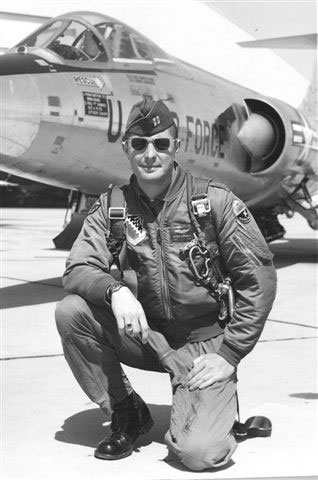
George J. Marrett is a former United States Air Force officer, combat veteran, and test pilot. He is the author of many aviation-related books and articles.
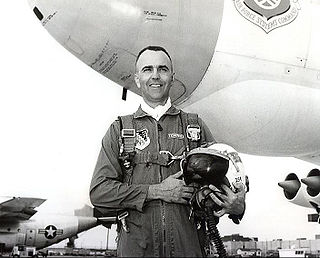
Guy Mannering Townsend III was a United States Air Force brigadier general, test pilot, and combat veteran. As an Air Force officer, he served as chief of bomber test at Wright-Patterson Air Force Base, flew as co-pilot on the first flight of the B-52 Stratofortress, was test force director for the XB-70 Valkyrie, and served as program director for the C-5 Galaxy and B-1 Lancer. He was the first military pilot to fly the B-47 Stratojet, B-50 Superfortress, B-52 Stratofortress, and the prototype of the KC-135 Stratotanker. During his years at Boeing, he was the head of the Supersonic Transport operations organization.

Walter J. Boyne was a United States Air Force officer, Command Pilot, combat veteran, aviation historian, and author of more than 50 books and over 1,000 magazine articles. He was a director of the National Air and Space Museum of the Smithsonian Institution and a Chairman of the National Aeronautic Association.
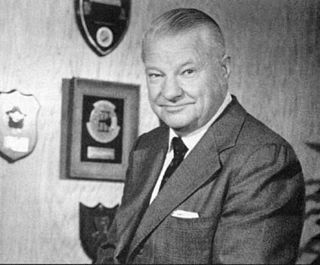
Clarence Leonard "Kelly" Johnson was an American aeronautical and systems engineer. He is recognized for his contributions to a series of important aircraft designs, most notably the Lockheed U-2 and SR-71 Blackbird. Besides the first production aircraft to exceed Mach 3, he also produced the first fighter capable of Mach 2, the United States' first operational jet fighter, as well as the first fighter to exceed 400 mph, and many other contributions to various aircraft.
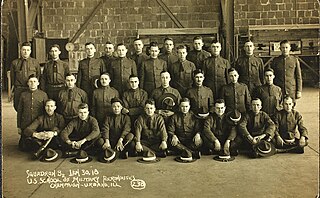
The Flying/Aviation Cadet Pilot Training Program was originally created by the U.S. Army to train its pilots. Originally created in 1907 by the U.S. Army Signal Corps, it expanded as the Army's air assets increased.

John Michael Conroy was an American aviator and later businessman, whose company Aero Spacelines developed the Pregnant Guppy, Super Guppy, and Mini Guppy cargo aircraft. He later founded Conroy Aircraft and Specialized Aircraft in Santa Barbara, California.

John Arthur Macready was an American test pilot and aviator. He is the only three-time recipient of the Mackay Trophy, and they were awarded in three consecutive years: once for altitude flight, once for transcontinental flight, and once for an endurance flight of 36 hours, 4 minutes and 32 seconds.
References
- ↑ "Space Wars". Macmillan. Retrieved 12 July 2010.
- ↑ "Speakers: Mr. William B. Scott". The 26th National Space Symposium. Archived from the original on April 19, 2010. Retrieved 12 July 2010.
{{cite web}}: CS1 maint: unfit URL (link) - ↑ "Guests: William B. Scott". Coast to Coast am. Retrieved 12 July 2010.